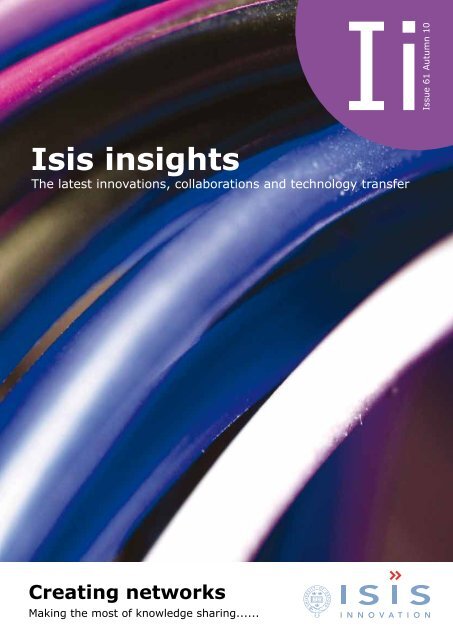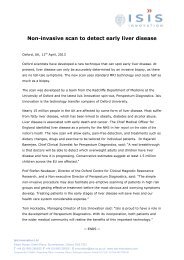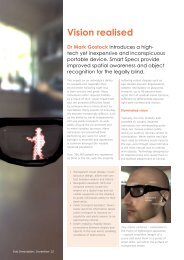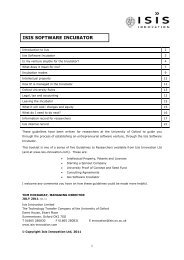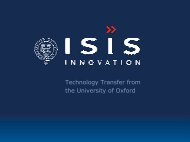Isis insights - Isis Innovation
Isis insights - Isis Innovation
Isis insights - Isis Innovation
You also want an ePaper? Increase the reach of your titles
YUMPU automatically turns print PDFs into web optimized ePapers that Google loves.
IiContentsThe Missing Link 14 Getting ahead of the Competition 20 For Your Information 2803. NewsflashThe latest news from <strong>Isis</strong>04. The <strong>Isis</strong> LoopA news roundup from OUC and <strong>Isis</strong> Enterprise05. The PortfolioInvestment and spin-out news06. Technology Steps ForwardThe latest licence agreements14. The Missing LinkProject 397416. Beating Breast CancerProject 422318. On the RadarProject 413420. Getting ahead of the CompetitionProject 717322. Immune to ChangeProject 399108. Bridging the GapThe Oxford Invention Fund10. In the PipelineSpin-out company OxEmS12. Investing in <strong>Innovation</strong>OIS member, Pradeyrol Recherche& Développement in profile24. Targeted TherapyProject 364526. Bitter SweetProject 382528. For Your InformationOxford University Consulting30. Local Knowledge<strong>Isis</strong> EnterpriseIi is produced by <strong>Isis</strong> <strong>Innovation</strong> Ltd, the technology transfercompany owned by the University of Oxford. For advertisingand editorial contributions, or to receive your free copy of Ii,email innovation@isis.ox.ac.uk<strong>Isis</strong> <strong>Innovation</strong>: Contents 02All trademarks are the property of their respective owners.
NewsflashInformationOxford fund to bridge ‘innovation gap’In May 2010, <strong>Isis</strong> <strong>Innovation</strong> launched the OxfordInvention Fund, as part of Oxford Thinking, theCampaign to raise a minimum of £1.25bn for thecollegiate University.A sustainable Fund, the OIF enables donors to supportproof-of-concept and prototyping work to turn moreresearch ideas into commercially-viable technologies,products and services.Following in the footsteps of the Oxford UniversityChallenge Seed Fund, also managed by <strong>Isis</strong>, proceedsfrom the new Fund will help bridge the ‘innovation gap’.“Many university-based inventions lack well-developedproduct prototypes and vital experimental data to helpthem succeed, and obtaining funds for such work fromventure capital providers or research funders is still aproblem,” said Tom Hockaday, Managing Director of <strong>Isis</strong><strong>Innovation</strong>. “The aim of this Fund is to support the workneeded to make even more Oxford inventions attractivepropositions for licensing or investment.”The Fund seeks to raise up to £5m, and <strong>Isis</strong> welcomesall donations. More information on the Oxford InventionFund can be found on pages 8 and 9.New MBAs gain innovation managementexperience<strong>Isis</strong> <strong>Innovation</strong> has awarded two three-month fellowshipsto MBAs graduating from the University’s Saïd BusinessSchool this autumn.The Fellowships are awarded annually on a competitivebasis, with applicants required to submit a 1,000 wordstatement explaining their personal interest in Universitytechnology transfer and innovation management. EachFellowship provides the recipient with £6,000 over thethree months they spend at <strong>Isis</strong>.This year’s Fellowships were awarded to NicholasMeadows and Evan Castiglia from a strong field ofapplicants. Nick has a PhD in Molecular Sciences fromQueensland, Australia and a career in research andtechnology transfer. Evan is from the US, with a degreein accountancy and business management, and a careerin consulting.Managing Director of <strong>Isis</strong>, Tom Hockaday, said: “TheFellowship Programme goes from strength to strengthand we are really looking forward to Evan and Nickspending time at <strong>Isis</strong>. They have strong skills andexperience complementary to the development of <strong>Isis</strong>business activities and the technology portfolio. We hopethey will gain <strong>insights</strong> into technology transfer andinnovation management and the role <strong>Isis</strong> plays in localand international technology networks.”<strong>Isis</strong> <strong>Innovation</strong>: Information 03
The latest newsfrom OxfordUniversityConsulting and<strong>Isis</strong> EnterpriseTheLoopAccelerating technologyParticle accelerators useelectromagnetic fields to propelcharged particles to high energies.Whilst they are often associated withhigh energy or nuclear physics suchas the large hadron collider (LHC)at CERN, they also find use in morewidespread applications, from thehumble cathode-ray tube totherapeutic and diagnosticmedical equipment. Evenultra-precision microscopy relies onaccelerating electrons to producesuitable wavelengths, and findsparallels with ultra-high-energybeams of other particles. Whileparticle accelerator designs varysignificantly depending on theintended application, they all drawheavily on a number of generic fieldsof technology, including: magnettechnology, radiofrequencyengineering, vacuum systems, powerelectronics and control engineering.The John Adams Institute (JAI) forAccelerator Science is a centre ofexcellence in the UK for advancedand novel accelerator technology,providing expertise, research,development and training inaccelerator techniques, andpromoting advanced acceleratorapplications in science and society.The institute is jointly hosted by thePhysics departments of theUniversity of Oxford and RoyalHolloway University of London, andis funded by the Science andTechnology Facilities Council (STFC).One of its main aims is todisseminate knowledge about thebenefits of accelerator technology toa wide community.The JAI is currently being led byProfessor Andrei Seryi,who succeeded the first Director,Professor Ken Peach in August 2010.Professor Seryi previously leddevelopment work at the SLACNational Accelerator Laboratory inCalifornia, as well as being the leaderof the Beam Delivery System for theInternational Linear Collider.Professor Peach has led the JAI fromits inception in 2005 and is also aCo-director of the Particle TherapyCancer Research Institute at theUniversity of Oxford.The JAI, via its AcceleratorTechnology Exploitation Centre(ATEC), seeks to developcollaborations with a wide range ofresearch and industrial partners thathave interests in different aspects ofaccelerator technology, and isinitiating a series of workshopsdesigned to promote suchinteraction. The next workshop eventis planned for the 6th October 2010and aims to engage both largecompanies and SMEs. OxfordUniversity Consulting offers suchbusinesses, and other organisations,a convenient means of accessingOxford’s accelerator expertise viaconsultancy agreements.Incubating innovation<strong>Isis</strong> Enterprise will gain first handexperience of the dramatic rate ofincrease of the Chinese hightechnology economy, ascollaborators on a new project tocreate a BioPharm incubator inChangzhou. Changzhou is situatedin the heart of the economically vitalYangtze River Delta, lying south ofthe Yangtze River, north of TaihuLake and halfway between Shanghaiand Nanjing.Dr David Baghurst says: “At <strong>Isis</strong> wehave first hand experience of sciencepark and businessincubator projects throughout theworld. One of the distinguishingfeatures of the Changzhou projectis the focus on rapidly turning goodideas into manufactured products.Given the close proximity to thegrowing Chinese market foradvanced medical researchtechnology, the prospects forbusinesses locating in Changzhou willbe excellent.”The BioPharm incubator will be aforerunner to the creation of a fullBioPharm science park and theproject has strong governmentsupport. According to Pengju Jiang ofthe Changzhou Science andTechnology Bureau: “FangyuanPharmaceutical Co. Ltd, a localentrepreneurial venture, is taking theresponsibility to build theincubator which is a top priorityproject for both the local governmentand the Changzhou State High-TechDevelopment Zone in 2010.”<strong>Isis</strong> is keen to talk to biotechnologyand pharmaceutical businesses witha desire to establish research,manufacturing or sales facilities inChina.Steve LeeHead ofOxford University ConsultingT +44 (0)1865 280824E steve.lee@isis.ox.ac.ukDr David BaghurstHead of <strong>Isis</strong> EnterpriseT +44 (0)1865 280858E david.baghurst@isis.ox.ac.uk<strong>Isis</strong> <strong>Innovation</strong>: Information 04
The latest spin-out andinvestment newsThePortf lioOxford PhotovoltaicsLimitedOxford Photovoltaics Limited (OxfordPV) is a proposed start-up companyfrom <strong>Isis</strong> <strong>Innovation</strong> and theUniversity of Oxford that meetsthe challenges faced by the currentphotovoltaic industry. Its aim is toachieve unsubsidised electricitygeneration costs that are equivalentto the Levelised Energy Cost (LEC) offossil fuels via its patentedSolid-state Dye-Sensitised Solar Cell(DSSC) technology.Oxford’s DSSCs are fabricated usingsimple screen printing techniquesand are constructed fromabundant, environmentally benignand extremely low cost materials.The efficiency of the demonstratorcells is impressive and the predictedmanufacturing costs are estimated at~50% below the current lowest costof thin film technologies. At 8%efficiency, Oxford PV cells arealready expected to competeaggressively on price withconventional technologies and havethe potential of realising an overallefficiency of more than 20%.The specific innovationsencompassed in the patentscovering this technology enableincreased solar light capture andcurrent generation efficiency,essential improvements in devicestability and scaling. Thebreakthrough solar cell issemi-transparent, capable of lastingfor 20 years and will facilitate thecreation of attractive and cheap solarglazing, not achievable with currenttechnology.The overall solar photovoltaicindustry is growing at a cumulativerate of over 40% per annum and ispredicted to become a $24bn marketwithin 2 years. Building IntegratedPhotovoltaics (BIPV) is an emergingmarket, where the PV modules areintegrated directly into the buildingarchitecture, for example as windowsor facades. The Oxford PVtechnology is likely to be of greatinterest in all market sectors,especially BIPV since its uniqueselling points are tuneable colour,transparency options and goodoperation under a wide range of lightconditions.Oxford Contrast MolecularDiagnostics Ltd.Oxford Contrast MolecularDiagnostics Ltd. (OCMD) is apotential spin-out from theUniversity of Oxford, supported by adecade of multi-disciplinary research.The company will developstate-of-the-art targeted MRIcontrast agents to provide earlierand more accurate diagnosis, andindeed ensure efficacy of treatmentin Multiple Sclerosis (MS), certaincancers and other inflammatorydiseases. The agents target earlyexpression of chemical markers fordisease before the changes inunderlying pathology could bedetected by current means. Thefounders have published theirbreakthrough results widely in highimpact journals.There is a long term morbidityassociated with MS due tochallenges in finding the right drugto treat a particular patient, andhigh annual treatment costs. OCMD’sagents offer a solution that will makea strong impact on both quality oflife and health economics.Two patents families will be licensedinto the spin-out which will operatea lean, outsourced business modelbased on strategic relationships witha cGMP manufacturer and aClinical Research Organisation(CRO).OCMD aims to close first roundfunding by late 2010, with asyndicate led by the venturing armof a pharmaceutical company. The£4m investment will enable OCMDto progress its first product (for MS)through preclinical stages, and tothe end of Phase I clinical trials. <strong>Isis</strong>would like to hear from investorsinterested in joining the syndicate.For more information pleasecontact:Andrea AlunniSeed Investment Manager<strong>Isis</strong> <strong>Innovation</strong>T +44 (0)1865 280843E andrea.alunni@isis.ox.ac.uk<strong>Isis</strong> <strong>Innovation</strong>: Information 05
The latest licence agreements signed by <strong>Isis</strong><strong>Isis</strong> licenses RF amplifiertechnology to AtlanticMicrowave Ltd.Designed and developed by theastrophysics team at Oxford, anew RF amplifier has recently beenlicensed to component company,Atlantic Microwave Ltd. through <strong>Isis</strong><strong>Innovation</strong>.<strong>Isis</strong> approached Atlantic MicrowaveLtd. as part of a routinecommercialisation exercise anddiscovered that Oxford amplifierscould diversify their product rangeand develop business in the scientificsector.Geoff Burling, C.E.O., said“Atlantic Microwave Ltd. hascultivated relationships with anumber of leading universities acrossthe UK, and having workedextensively with the radio astronomygroup at Oxford, it seemed onlynatural to see how they could helpus.”Following discussions there was aquick realisation that theinventions Oxford has developedcould also have potential applicationsin other sectors that AtlanticMicrowave Ltd. serves. Further toextensive product evaluation, thecompany signed a licenceagreement with <strong>Isis</strong> for themanufacture and commercialexploitation of an extremely versatile1 to 20GHz amplifier designed by theOxford astrophysics team.Burling commented “This agreementwith Oxford University through <strong>Isis</strong><strong>Innovation</strong> marks a significant stepforward in our product offering and Iam very positive about future salespotential.”Commercial sales and designs of theamplifier have already commencedand Atlantic Microwave Ltd., <strong>Isis</strong>and Oxford are now in discussionsregarding further productopportunities.“We are delighted that the teams’research outcomes were of suchsignificant interest to AtlanticMicrowave Ltd., and at having theopportunity to establish a licenceagreement of this kind,” said DrRakesh Roshan, Project Manager, <strong>Isis</strong><strong>Innovation</strong>.About Atlantic Microwave Ltd.Atlantic Microwave Ltd. was founded20 years ago as a distributor ofmicrowave and RF components butvery quickly branched out into themanufacture of custom testequipment and phase lockedoscillators. Today, the companysupplies a wide range ofcomponents and equipment to theglobal marketplace in aerospace,telecommunications, defence andscientific research. AtlanticMicrowave Ltd. has always been asignificant supplier of amplifiers andamplifier systems, commercial andmilitary, across frequencies from afew MHz to over 100GHz.www.atlanticmicrowave.co.ukFor more information pleasecontact:Dr Rakesh RoshanProject Manager<strong>Isis</strong> <strong>Innovation</strong>T +44 (0)1865 280853E rakesh.roshan@isis.ox.ac.uk<strong>Isis</strong> <strong>Innovation</strong>: Information 707
<strong>Innovation</strong>Bridging theGap<strong>Isis</strong> <strong>Innovation</strong> reports on its newfund which aims to bridge the‘innovation gap’, enabling Oxfordresearch to be turned intocommercial technologies, productsand services.<strong>Isis</strong> <strong>Innovation</strong>: Information <strong>Innovation</strong> 088
“The Oxford Invention Fund provides the opportunityfor donors to the University to see their donations usedto support innovation and enterprise in Oxford, and tosee a return to the University from successful newbusiness ventures.”The ‘dreaming spires of Oxford’ areknown around the world as a havenfor learning. To make the most of thislearning, Oxford also endeavours toexcel at identifying, protecting andfinding commercial partners for ideasthat will make a difference insupporting both the excellence ofOxford and helping to improve thehealth and wealth of society.It is widely recognised that there isan ‘innovation gap’ between theearly stages of an invention or ideaand the point when it is matureenough to be commercialised througha license or spin-out company. Thenew initiative aims to raise up to £5mto create a self-sustaining fund tohelp develop Oxford inventions to thepoint where they can attractcommercial investment.Through this new Fund, Oxford willstrive to ensure that smart ideas willbe developed to a stage where theycan be transferred from theUniversity to business. This can beachieved by setting up newcompanies, or by licensingtechnologies to existing innovativebusinesses with the capability tobring new products to market.“The Oxford Invention Fundprovides the opportunity for donorsto the University to see theirdonations used to supportinnovation and enterprise in Oxford,and to see a return to the Universityfrom successful new businessventures,” said Bernard Taylor,Chairman of <strong>Isis</strong> <strong>Innovation</strong>.<strong>Isis</strong> <strong>Innovation</strong> has a longtrack record of success in exploitingresearch discoveries and ideas fromthe University of Oxford. In the lastten years <strong>Isis</strong> has set up 54 newtechnology spin-out companies andconcluded 500 technology licensingtransactions. <strong>Isis</strong> currently managesover 750 technology projects andfiles on average more than one newpatent application each week.<strong>Isis</strong> <strong>Innovation</strong> has managed thehighly successful Oxford UniversityChallenge Seed Fund (UCSF) which,since it was first launched in 1999,has awarded £5.7m, financed 102projects, prompted the formation of31 spin-out companies, andcompleted 51 commercial deals.The Oxford Invention Fund ismodelled after the UCSF, withreturns from its investmentsre-invested in further projects sothat it can continue to supportinnovation at Oxford for many yearsto come. It is hoped that one daymoney generated from the Fundcould be used to subsidisescholarships and bursaries to helpthe next generation of inventors andscientists.Examples of successes from theUCSF include:Oxitec – Based on technologydeveloped by Dr Luke Alphey andcolleagues at Oxford’s Departmentof Zoology, Oxitec is developingenvironmentally-friendly insect pestcontrol. In 2001, at a critical time inthe company’s development,Oxitec received four awards from theOxford UCSF totalling £288,775. Thecompany was spun out by <strong>Isis</strong><strong>Innovation</strong> in 2002. It now employs30 people and is developingproducts to tackle, amongst otherpests: disease-carrying mosquitoes,cotton-eating bollworms andflesh-eating maggots.www.oxitec.comOxford Catalysts – Spun out by <strong>Isis</strong><strong>Innovation</strong> in 2005, OxfordCatalysts was listed on the AIM stockexchange four months later with amarket capitalisation of £65m. Itis the culmination of 19 years ofresearch at Oxford’s Departmentof Chemistry by Professor MalcolmGreen and Dr Taincun Xiao. In 2001it received a £124,500 award fromthe Oxford UCSF to beginoptimising catalysts for industrialprocesses such as producingsulphur-free diesel fuel from wastegas and removing sulphurcontamination. It is now leadinginnovation into catalysts for cleanfuels.www.oxfordcatalysts.comNaturalMotion – Algorithmsdeveloped by Torsten Reil andcolleagues at Oxford’s Department ofZoology are at the heart of softwarefrom spin-out NaturalMotion thatenables video game characters tointeract with and respond to theirvirtual environment. A £23,500 grantfrom the Oxford UCSF in 2000enabled them to start programmingand NaturalMotion was spun out by<strong>Isis</strong> <strong>Innovation</strong> in 2001. Since thenthe technology has been used infeature films such as Troy as well asvideo games such as Star Wars: TheForce Unleashed and Grand TheftAuto IV.www.naturalmotion.comFor more information on theOxford Invention Fund pleasecontact:Andrea AlunniSeed Investment Manager<strong>Isis</strong> <strong>Innovation</strong>T +44 (0)1865 280843E andrea.alunni@isis.ox.ac.uk<strong>Isis</strong> <strong>Innovation</strong>: <strong>Innovation</strong> 09
In thePipeline<strong>Isis</strong> spins out a new University of Oxfordcompany, Oxford Electromagnetic SolutionsLimited (OxEmS), set up to commercialise arange of tagging and sensing technologiesthat will help to locate and identify buriedplastic pipes.As the utility infrastructure ages,metal pipes, such as cast iron gasmains, are rapidly being replacedwith plastic ones. However, buriedplastic pipes are notoriously difficultto detect using current methodswhich are expensive, inefficient andin many cases do not produce thequick and accurate results required.The new tag and sensor technologyOxEmS is deploying was developedat the Department of EngineeringScience and uses an extension ofRadio Frequency Identification andDetection (RFID) and passive lowfrequency tags to give each buriedplastic pipe a unique frequencydomain ID, rather like a 'barcode'.The pipe's location and this codewhich provides immediateinformation on the type of servicecarried as well as providing access toremote data related to the asset, canbe detected from the surface using anew locator which OxEmS isdeveloping.It is estimated that there are over4 million kilometres of buried pipesand cables in the UK, with around100,000km of cast iron gas mainsconsidered at high risk of failure andin need of replacement. It isintended that the new technologywill detect all kinds of buriedinfrastructure, including water, gas,power, and telecommunications, andcould reduce the costs to companiescarrying out street works by at least40%.The new system is designed to below cost to install, robust andrequires very little maintenance.Crucially it also performs well in wetconditions, which is essential forpinpointing failed pipes responsiblefor water leaks.<strong>Isis</strong> <strong>Innovation</strong>: Information <strong>Innovation</strong> 10 10
“It also means lessstreet workdisruption for therest of us, with nomore ‘dry holes’where a contractordigs a hole but findsnothing.”Professor David Edwards of theDepartment of Engineering Scienceled the founding team comprising DrHarvey Burd, Dr Christopher Stevensand Dr Tong Hao that developedthe technology at the University ofOxford.Professor Edwards said: “Weoriginally started working on theproblems industry faced in this areaas part of the ‘Mapping theUnderworld’ call from theEngineering and Physical SciencesResearch Council (EPSRC), which ledto the domain ‘barcode’ approach.Our previous work in underwaterpipe detection enabled us to modelthe response from wet environmentsand develop the OxEmS technologybased on a long history of workingon long range detection andpositioning systems.”Kevin Gooding, CEO of OxEmS, said:“One of the major benefits to utilityfirms of the OxEmS solution is thatthe ‘intelligent’ part of thetechnology is on the surface, so thatthe buried tagging units are simple,leading to significantly reduced unitcosts as well as increased reliabilityand longevity. It also means lessstreet work disruption for the rest ofus, with no more ‘dry holes’ wherea contractor digs a hole but findsnothing.”Tom Hockaday, Managing Director of<strong>Isis</strong> <strong>Innovation</strong> said: "We aredelighted to have worked with theOxEmS team, to develop thebusiness plan, help attractinvestment and senior managementto launch this exciting newtechnology business."For more information please contact:Dr Rakesh RoshanT +44 (0)1865 280853E rakesh.roshan@isis.ox.ac.uk<strong>Isis</strong> <strong>Innovation</strong>:<strong>Isis</strong> <strong>Innovation</strong>: <strong>Innovation</strong> 11
Oxford <strong>Innovation</strong> Society members, PradeyrolRecherche & Développement give us an insight intothe company and an overview of some of thetechnologies that they have helped to deliver, fromvaccines to solar panels.Investingin<strong>Innovation</strong>The Oxford <strong>Innovation</strong> Society thisyear celebrates its twentiethanniversary and can proudly claimduring this time to have become aleading forum for open innovation.Founded by <strong>Isis</strong> <strong>Innovation</strong> in 1990the Society connects researchersand inventors from the University ofOxford with technology transferprofessionals, local companies,venture capital groups and some ofthe most innovative multinationalcompanies from around the world.One of the most recent newMembers of the Oxford <strong>Innovation</strong>Society is French investment andholdings company, PradeyrolRecherche & Développement. Havingestablished a licence agreementearlier this year with a Frenchcompany with whom PradeyrolRecherche & Développement isinvolved, <strong>Isis</strong> is pleased that we cannow continue to develop thisrelationship through the Oxford<strong>Innovation</strong> Society.Since joining the Society in May,Pradeyrol Recherche &Développement have received anumber of exclusive membershipbenefits, including invitations tothrice annual Oxford <strong>Innovation</strong>Society meetings and dinners, 30days’ advance notification ofemerging Oxford technologies andpatent applications, and the chanceto have their company profilepublished in <strong>Isis</strong> <strong>insights</strong>, as featuredhere.Dr Christian Pradeyrol started hiscareer as a General Practitionerbefore specialising inAnaesthesiology, and later going onto manage a team of hospitaldoctors. In 1979 he founded anddeveloped a group of privatehospitals located in the Auvergne,Brittany and Monaco which realiseda turnover of €100 million with areturn of 12%. A few years ago, hecame to the conclusion that an SMEactive in the field of hospital careneeded to benefit from the structureand resources of a group of nationalor European scale in order to strivefor excellence and ensure acontinued quality of patient care.<strong>Isis</strong> <strong>Innovation</strong>: Information <strong>Innovation</strong> 12 12
“Pradeyrol Recherche& Développement setitself a mission and aphilosophy to facilitatethe emergence of newtechnologies andsupport the companiesdeveloping them.”To that end, in 2007, Dr Pradeyrolaccepted an offer from Vitalia, agroup backed by Blackstone, theAmerican Investment Fund, to takeover the clinics. They have sincebecome the second largest group forhealth services in France.Pradeyrol Recherche &Développement, a family owned andactive investment holdingcompany, was created at the end ofthis handover. With more than €120million of equity and shares invarious sectors, its investments,majority as well as minority, focus onfour areas of activity:• Biotechnology.• Energy and sustainabledevelopment.• Telecommunications andinternet.• Real estate and hotel business.Pradeyrol Recherche &Développement is currently involvedin around 20 partnerships whichinclude the following:• Imaxio, a biotechnologycompany specialising inprotein engineering,immunology, genomics andsequencing, which is alsoactive in the fields of diagnostics(DNA chips) and vaccines. Thishas included, most notably, theSpirolept vaccine designed totreat leptospirosis. The disease,carried by animals, typicallylivestock (the Hardjo form) androdents (Weil’s disease), can bepassed to humans through fleshwounds, as well as contaminatedwater supplies. Classed as anoccupational disease, it poses aparticular threat to theagricultural industry, withfarmers and animal workersbeing the most vulnerable to theillness.• Cyclopharma laboratories, activein the fields of nuclear medicineand radio-pharmaceuticals.• Auversun, a companymanufacturing photovoltaicpanels and producing electricity.• Wifly which deploys broadbandinternet networks andcommercialises internet servicesin Central Africa (Gabon and theCongo) via the companiesWax-Com and Boost’ Africa.• Hotel business in Paris.Pradeyrol Recherche &Développement’s investmentstrategy is to be involved right fromthe start of a company (e.g.Imaxio, Wifly and Auversun) or totake minority shareholdings indeveloping companies (e.g.Cyclopharma). This way thecompany invests in equity and islong-term orientated, with noconstraints, unlike investment fundswhich intervene on behalf of a thirdparty.Pradeyrol Recherche &Développement’s mission andphilosophy is to facilitate theemergence of new technologies andsupport the companies developingthem. Pradeyrol Recherche &Développement is also proud to takepart in a number of incubation fundsset up by such innovative andpromising companies.For more information pleasecontact:Isabelle CalmettePA to the Director+33 173 02 9450icalmette@pradeyrolrd.comThe Oxford <strong>Innovation</strong>Society is the leading forumfor open innovation, fosteringlinks between business andthe academic community.For more information pleaseemail us atinnovation@isis.ox.ac.uk<strong>Isis</strong> <strong>Innovation</strong>:<strong>Isis</strong> <strong>Innovation</strong>: Information <strong>Innovation</strong> 13
InventionTheMissingLinkBrendan Spillanereviews the benefitsof linking data sothat organisationscan accessinformation storedon different systems,and share it withcolleagues securelyand quickly.Data on demandThere are many situations where it isdesirable to link data from separatedata sources. For example, considerthe case of two recently mergedbusinesses where there is an urgentneed to see an overall ‘picture’ ofthe new organisations’ operationsby combining data from existingsystems with different functionalities.Or imagine a healthcare scenario inwhich there is a need for data thatis distributed between clinics to becombined to provide effective care.Another situation might be wherea centralised data store dominatesan enterprises’ operations, but eachunit continues to run its own ’local’system. In each case, a lightweight,secure means of combining datafrom the different systems wouldbring significant benefits: allowingcrucial tasks to be undertaken swiftlywithout waiting for new systems tobe put in place. Importantly,users and applications are allowedto access exactly what they need toperform a specific task - eliminatingthe need to transfer data via DVD orUSB drive.Overcoming linkinghurdlesThere are, though, challenges to beovercome: the data might be held ondifferent database managementsystems, meaning that there areissues ensuring the systems worktogether to think about. Security isalso a key consideration - while thebenefits of linking data aresignificant, so are the risksassociated with grantinginappropriate access in suchcircumstances.A new invention developed at theUniversity of Oxford facilitates thelinking of data from existing,networked data stores in astraightforward fashion where datais exposed and shared via standardinterfaces (permitting only a subsetof data to be shared). This allowsapplications to utilise aggregateddata from disparate systems. As wellas being easy to use, the technology<strong>Isis</strong> <strong>Innovation</strong>: Invention 14
Beating Breast CancerBrendan Spillanediscussesmammographyfollowing growingconcerns about itseffectiveness. Here headdresses how a newmethod for producingcomparable,quantifiable results, couldreduce patient x-raydoses and improveautomated diagnosisand computerisedscreening.Mammography – asensitive subjectIt’s no secret that breastscreening techniques such asmammography are a controversialtopic – for the woman waiting to bescreened, or a medical professionalcaught in the debate about howuseful the procedure really is incatching cancer early on. Following aflurry of recent bad press, and newarguments against the procedure,the NHS Breast ScreeningProgramme has come under greatscrutiny, raising the question ‘couldmammography be doing more harmthan good?’. With more than2 million women being screeneda year in the UK alone as part ofthe £75 million programme, it’s asubject for careful consideration witha number of factors to think about,including cost effectiveness andaccuracy.Improved information usinga new approachClinical mammography is currently aqualitative technique that relies onobservation from one or more skilledpeople based on therecognition of particular featureswithin an image. It is not possibleto directly compare the images bycomputer. As such results are opento interpretation, and this may gosome way to explaining why criticsare concerned that currentmammography methods mayultimately result in the falsediagnosis of cancer and unnecessarytreatment. By contrast, the Oxford<strong>Isis</strong> <strong>Innovation</strong>: Invention 16
“The invention is opening up the potential for anext generation of diagnostic techniques, bothfor radiologists and computer aided detection.”invention transformsmammography into a quantitativetechnique, in which comparison maybe made directly between images,patients, and model data for the firsttime.The system also removes thecontrast degrading effects ofscatter, allowing the removal of thelead anti-scatter grid, and therebylowering the otherwise potentiallyharmful radiation dose. This isespecially important since ascreening patient is likely to behealthy.With over 82 breast screening unitsin the UK, the screening programmeis currently open to women agedbetween 50-70, however by 2012 itis expected to be made more widelyavailable to the 47-73 age group.Recent studies show that digitalscreening is particularly effective inyounger women and so is animportant part of the futuredevelopment of the programme.The invention is opening up thepotential for a next generation ofdiagnostic techniques, both forradiologists and computer aideddetection. The improvement inspecificity and sensitivity ofmammography will reduce missedcancers, false alarms and theresulting stress to patients; andhelp reduce economic burden bystreamlining the clinical workflow.The method is also applicable to theemerging 3D market of bothTomosynthesis and ComputedTomography, and state-of-the-artspectral x-ray detectors, such as theMedipix developed at CERN. This wasoriginally for use in the Large HadronCollider, and further enhances thediagnostic capabilities of theinvention.Global healthcare priorities– tackling cancerworldwideBreast cancer is one of the primarycancers affecting women and aleading cause of mortality,particularly in developed countries.The earlier the diagnosis, thebetter the prognosis, and this has ledboth to greater awareness of breastcancer and to the introduction ofnational screening programmes inmany countries. Currently, oneof the most importanttechnologies used to detect breastcancer is mammography – an x-rayimage of the breast, and it is thoughtto have reduced mortality by 35%,saving approximately 1400 lives ayear. It is estimated that 60 millionmammograms are taken annuallyaround the world, a number that isrising quickly, especially asmammography becomes moreregularly used in Asia. The marketwill grow further when 3Dmammogram scanning technologymoves from research to clinical use.The Oxford invention is the subjectof a patent application. <strong>Isis</strong> wouldlike to talk to companies interestedin developing the commercialopportunity.For more information pleasecontact:Brendan SpillaneT +44 (0)1865 614423E brendan.spillane@isis.ox.ac.ukRef: 4223<strong>Isis</strong> <strong>Innovation</strong>: Invention 17
On theRadarDr Rakesh Roshan reveals how newhigh performance antenna arraysdeveloped at the University ofOxford can be manufactured quicklyand affordably for use in radioastronomy, radars and tele andsatellite communication.Smooth walled feed hornantennasFeed horns are the part of thesatellite antenna that capture radiosignals from space and feed theminto the waveguide. A feed horn canbe as simple as a hollow,conical conducting cone, but willusually have a more sophisticateddesign in order to more efficientlycouple incoming radiation from agiven direction into a waveguide andthen to a detector. Feed horns areused on radio telescopes to receiveradiation from the primary dish andon communication satellites toreceive and transmit signals directlyto earth.Conventional feed horn antennassuch as corrugated horns aredifficult, time consuming andexpensive to manufacture in the mmand sub-mm range (~100GHz to1THz), due to the need tofabricate small sized, quarterwavelength (~100 - 400µm) deepcorrugations. The metal walls forcurrent horns also need to be thickenough to accommodate thesecorrugations. At lower frequencies(~ 5GHz - 100GHz), where deepercorrugations are needed, thisconstraint on wall thickness canmake the weight of these horns toolarge for key applications such asspace telescopes and communicationsystems.<strong>Isis</strong> <strong>Innovation</strong>: Information Invention 18 18
“The current prototypes showexcellent performances at 230GHzand designs at other frequencies arealso being tested.”The Oxford technology overcomesthese problems and aims to replacethe conventional corrugated hornsfor many applications. Designedusing a fully automated suite of horndesign software that uses a genericalgorithm, the proposed productoffers excellent predicted patternsover a bandwidth of 20-30%.Enhanced sky mappingspeedOxford horns offer severaladvantages including:• Fabrication of lower costmm-wave microwave receivers.• Allowance for 10 to 100 timesmore horns to be integrated intoan antenna's focal plane as anarray at no added cost.• Increased sky mapping speedand scientific output for mm/subradio telescopes.Current prototypes showexcellent performances at 230GHzand designs at other frequencies arealso being tested. Closed packed 2horn arrays demonstrate excellentperformance with negligiblevariations between the horns,showing good beam patterns and lowcross coupling. The researchers arecurrently characterising a prototypewith a 37 horn array at 230GHz.Getting the messageacrossThere is an extensive commercialopportunity for the feed horns withinthe multibillion-dollar scientific andcommunications markets. The keycost and manufacturing advantagesfor these smooth walled antennasopen up further opportunities suchas use in both ground-based radiotelescopes and the satellitecommunications market. Initialtarget markets would includeresearch groups building mm andsub-mm astronomical receivers. Weare also investigating the marketpotential of these horns for remoteearth sensing.<strong>Isis</strong> would like to talk to companiesor investors interested incommercialising this opportunity.For more information pleasecontact:Dr Rakesh RoshanT +44 (0)1865 280853E rakesh.roshan@isis.ox.ac.ukRef: 4134<strong>Isis</strong> <strong>Innovation</strong>:<strong>Isis</strong> <strong>Isis</strong> <strong>Innovation</strong>: Information Invention 19
Getting aheadof the CompetitionEvert Geurtsen discusses the ways that Dynamic OnlineSports Ranking could change our sports experience, helpto promote events and improve performance monitoring.<strong>Isis</strong> <strong>Innovation</strong>: Invention 20
The number and density ofmedia channels continues to grow:high definition and 3D television,IPTV, mobile phones, YouTube, webstreaming, digital radio, iPlayer,games consoles, and socialnetworking sites to name but a few.As these outlets develop the demandfor content, preferably live andinteractive, will continue to grow.Sport seems to fit the bill and withinthis exciting market, the Universityof Oxford can now offer DynamicOnline Sports Ranking (DOSR) - anew way to convert sports statisticsinto an interactive format forprofessional and amateur athletes,fans and spectators as well as sportsclubs, associations and eventorganisers. DOSR uniquely combinessports statistics and performancetracking with interactivity and socialnetworking. It is also a great vehicleto attract web-user interest andtraffic to promote sports, enhancemajor sporting events andcompetitions, identify individuals andathletes and promote sportsproducts online.DOSR is already in the second yearof operations in the Polish runningmarket, both for recreational andperformance running, where it issponsored by PUMA. The know-howthat enables this Polish prototypehas now been assigned to <strong>Isis</strong><strong>Innovation</strong> for worldwide exploitationacross a wide range of sports.DOSR links a considerable numberof functionalities including a dynamicdatabase, online presence, rankingalgorithm, online content,inter-operability with onlinepublications and social networking.At the core of DOSR is a means ofmeasuring and normalising personalperformance and comparison withexisting records. This creates a rangeof statistics at individual or clublevel. For instance it allows a fan,agent or journalist to analyse theperformance of a particular athleteor an individual amateur sportsmanto compare his or her performanceagainst any listed professional, or aclub to track the relativeperformance of their members.Sport fansThe principal advantage for sportsupporters is the convenientpresentation of performancestatistics of athletes, both the toprecognisable athletes and those whoare up and coming. Users can tracktheir performance and compare itwith other athletes from past andpresent. With links to photographsthey can easily put a face to whatwas previously an anonymousperformance history.Professional athletes andadvertisersFor athletes and their agents it offersearly recognition as well asbranding power. For advertisers,branding is safely distributed overthe entire sport reducing the risk offocusing on one athlete.Sports federations and eventorganisersSports federations have a vestedinterest in developing their sportsboth in a traditional sense of“The principal advantagefor sport supporters is theconvenient presentation ofperformance statistics ofathletes, both the toprecognisable athletes andthe ones who are up andcoming.”charitable social enterprise, andincreasingly as a sports business thatseeks new ways of marketing. DOSRcan provide clear evidence andquantification of public interest.MediaFor journalists, editors andproducers in the media it adds a toolthat is objective and can beeasily used for creating content.Media coverage bolsters thepublic interest in, and viability of,any sport.Fusion of conceptsDOSR fuses ideas from Google, pricecomparison websites and TVreality shows to present, promoteand personalise upcoming sportscelebrities. For any portaloperator DOSR can provideconsiderable added online interestand lucrative sponsorship andadvertising opportunities. UniquelyDOSR adds a social networkingelement to sports statisticsencouraging participants to compareperformance, contribute commentsand exchange sports experiences.DOSR will enable ‘virtual’ clubs andnetworks of athletes, fans andcommentators.With research indicating that sportsfollowers are turning away from thepassive narratives of TV andnewspaper coverage towardsinteractive online statistics, DOSRprovides the means to capitalise onthis trend.IP statusThis work is the subject of copyrightand <strong>Isis</strong> would like to talk toorganisations and companiesinterested in developing commercialopportunities.For more information please contact:Evert GeurtsenT +44 (0)1865 614424E evert.geurtsen@isis.ox.ac.ukRef: 7173<strong>Isis</strong> <strong>Innovation</strong>: Invention 21
ImmunetoChangeDr Carolyn Porter looks at the partpriming and boosting plays indeveloping a new generation ofvaccines that provide betterprotection against diseases such astuberculosis and HIV.Only ten years ago vaccines wereviewed as the poor relation of thepharmaceutical industry, associatedwith slow growth and poor margins.Fast forward to 2010 and the vaccinemarket is one that majorpharmaceutical companies arejumping into, rather than out of, withAstraZeneca’s acquisition ofMedImmune sitting alongside Pfizer’sdecision to develop vaccines(enhanced by its recent mergerwith Wyeth). The size of the globalmarket is estimated in 2010 to be inexcess of $20bn with a growth rateas high as 20%.Preventing pandemicsWhat are the reasons for thischange? A movement from paediatricto adult vaccines targeting westernhigh margin markets has helped,with sales of influenza vaccines inparticular swelled by the recentswine flu outbreak. Increased publicfunding support for neglecteddiseases such as tuberculosis,malaria and HIV has also providedcompanies with an incentive todevote significant resources – andnew technologies – to developingnext generation vaccines fordeveloping world markets.<strong>Isis</strong> <strong>Innovation</strong>: Information Invention 22 22
“‘Prime/boost’ refers to priming a vaccineewith one vector which encodes a specificantigen, followed by boosting some timelater with a different vector encoding thesame antigen.”Understanding of the underlyingimmunology of some of the mostneglected diseases – notablytuberculosis and malaria – has alsoimproved over the last 10 years,especially in relation to theimportance of generating T-cellmediated immune responses inaddition to, or instead of, antibodyresponses. Non-traditional vaccinesusing replication deficient virusesas carriers (or vectors) for antigensspecific for a given pathogen haveemerged as highly effectivecandidates, particularly when usedin a manner referred to as ‘prime/boost’.Boosting immunity‘Prime/boost’ refers to priming avaccinee with one vector whichencodes a specific antigen, followedby boosting some time later with adifferent vector encoding the sameantigen. Immune responsesfollowing the boost tend to besignificantly greater as measured bythe number of antigen specificT-cells generated. The use ofdifferent vectors for the primingand boosting steps is thought to becritical: if the same vector is usedfor both, the results are inferior,most likely as a consequence of thevaccinee becoming immune to thevector itself.While ‘prime/boost’ has wellestablished advantages, the use oftwo different compositions for thepriming and boosting agents is notideal, requiring separate formulationsand raising the prospect of greatercosts and lack of compliance.In order to investigate ways in whichthese limitations might beovercome and the practicality ofadopting ‘prime/boost’ regimens,Oxford researchers at the JennerInstitute examined the use ofidentical mixtures of different virusesin such approaches. In a departurefrom current thinking, they were ableto show that the administration ofan adenovirus and a pox virus vectoror two different adenovirus vectors(each encoding the same antigen) atthe same time or very close togetheris remarkably immunogenic andprotective. The initial data showsT-cell responses and protection in amouse malaria model comparable ifnot superior to results withheterologous regimens, and testingin other diseases is underway.Such mixtures enable the use oflower doses of vectors in a singleformulation and allow the repeatedadministration of the same vectorswhile avoiding anti-vector immunityproblems. The immune responsesgenerated are not only of greatermagnitude but also greater breadth,as demonstrated by responses bothto dominant and sub-dominantepitopes likely to be important inmaximising the chances oftranslating immunogenicity intoprotective efficacy.<strong>Isis</strong> has worked with the researchersto file a patent applicationprotecting this new approach tovaccination and would like to speakto companies interested in applyingit to new vaccines for human andveterinary markets.For more information pleasecontact:Dr Carolyn PorterT +44 (0)1865 280931E carolyn.porter@isis.ox.ac.ukRef: 3991<strong>Isis</strong> <strong>Innovation</strong>: Invention 23
TargetedTherapyDr Brijesh Roy explains how scientists haveused tissue-specific microRNA (miRNA)expression to create a new class of live viralvaccines which increase immunity whilstpreventing unwanted side effects.MicroRNA and bespoketargetingMiRNAs offer the possibility of saferand more targeted vaccines withgreater efficacy. They can be used toprevent virus replication in the partsof the body where they can causeundesirable symptoms, whilst at thesame time helping the immunesystem to arm itself against thevirus.Although the first miRNAs werecharacterised in the early 1990s, itis only in the last decade that theyhave been recognised as a distinctclass of biologic regulators. MiRNAsare short strings (~22 nucleotides)of highly conserved non-coding RNAthat play a role in normal generegulation. They can inhibit proteinexpression by binding to target siteson messenger RNA and therebyprevent its translation. Ongoingresearch has led to the growingawareness that many miRNAs exhibithighly tissue-specific expressionpatterns. The aberrant expression ofmiRNAs has also been implicated ina number of diseases. Not only havethese discoveries led to thedevelopment of research tools toinvestigate this emerging area ofgene regulation, but this technologyis also being utilised to developdiagnostic and therapeuticapplications.Therapeutic possibilitiesThere are a number of approachesthat can be used for the generationof viral vaccines. Attenuated vaccinesutilise viruses that are still alive, buthave been altered to render themless virulent and effectivelyharmless. These represent the mostimmunogenic and cost-effectivemeans to prevent viral infections.Ideally, a viral vaccine wouldreplicate robustly within the body soas to elicit a complex andlong-lasting immune response, whileat the same time not causing anypathologic effects.A group of Oxford researchers led byProfessor Leonard Seymour, Head ofthe Department of ClinicalPharmacology, have developed astrategy to use miRNAs as a novel<strong>Isis</strong> <strong>Innovation</strong>: Information Invention 24 24
“The technology isat preclinicalresearch stage andcell andtissue-specificattenuation hasbeen demonstratedin a number ofmodels.”route to viral attenuation. The teamhave engineered binding sites fortissue-specific miRNAs into thenon-coding regions of the viralgenome, taking control of the virus’replication abilities.The technology is at preclinicalresearch stage and cell andtissue-specific attenuation has beendemonstrated in a number ofmodels:• In vitro – hepatocyte-specificsuppression of luciferaseexpression in cell-culture.• In vivo – removal of lethal livertoxicity of wild type adenovirusin a mouse model, withoutaffecting virus replication in1other tissues.• Non-Oxford researchers aroundthe world have also successfullyexemplified the technology ina number of other viruses and2,3viral vaccines.Targeting the marketThe Oxford invention is protected bya published international5patent application. Thistechnology has the potential toaddress the growing vaccines market4forecast to be worth $50bn in 2015.<strong>Isis</strong> would like to talk to companiesand investors interested incommercialising this opportunity.1 Cawood et al, PLoS Pathog. 2009 May; 5(5): e1000440; 2 Barnes et al CellHost Microbe. 2008 Sep 4(3): 239–248; 3 Perez et al Nature Biotechnology 27,572 - 576 (2009); 4 Frost and Sullivan – Global Vaccines Market 2009; 5 WO2009/130479 ‘Virus’.For more information pleasecontact:Dr Brijesh RoyT +44 (0)1865 280842E brijesh.roy@isis.ox.ac.ukRef: 3645<strong>Isis</strong> <strong>Innovation</strong>: Invention 25
BitterSweetDr Sarah Deakintakes a look at how anumber of lifestylerelated medicalconditions such asdiabetes, heartdisease andhypertension couldbe treated bytargeting the newlydiscovered NAADPreceptors, TPC1 andTPC2.It is an unfortunate reality that ourlifestyle choices today can negativelyimpact on our health, and conditionsincluding obesity and type 2 diabetesare among the biggest healthcarechallenges facing the world. Oftencompounded by a number of lifestylefactors such as poor diet and lackof exercise, as well as smoking andexcessive alcohol consumption, type2 diabetes is now increasinglycommon, affecting over 2 millionpeople in the UK alone. For peoplecontinuing to juggle demandingworkloads with family commitments,trying to control these factors isbecoming ever more difficult, andfurthermore, diabetic patients arealso likely to be at increased risk ofarterial diseases, heart attack andstroke.A non-insulin dependent form ofdiabetes, type 2 diabetes iscontrolled by the body’s ownproduction of pancreatic insulininstead of medication. Regulatingthis production and maintainingproper function of this is thereforeinstrumental in treating thecondition. With this is mind,researchers at the University ofOxford have been investigating hownormal cells function, their part indisease, and therefore how newtherapy strategies can bedeveloped for diabetes and otherchronic diseases.<strong>Isis</strong> <strong>Innovation</strong>: Invention 26
Understanding calciumand normal cell functionCalcium ions (Ca2+) impact nearlyevery aspect of the life of a cell. Toadapt to changing environments,cells must communicate with eachother which they do by releasinghormones and neurotransmitters.These extracellular signallingmolecules do not enter the cells theyare communicating with, but theybind to receptors on the cellsurfaces. These receptors then relaythe signal to the inside of the cellusing second messengers, such asCa2+. The exact intracellular targetsof this Ca2+ release are dependenton cell type, but all cells use Ca2+for their function, making Ca2+of universal importance in normalcell function and so in health anddisease.All cells contain stores of Ca2+, andthere are numerous other messengermolecules which can mobilise them.This mobilisation of Ca2+ fromstores within the cell is an importantprocess in transmitting a signal andis regulated (in mammalian cells) bya number of molecules -inositol-1,4,5-triphosphate (InsP3),cyclic ADP ribose and Nicotinic AcidAdenine Dinucleotide Phosphate(NAADP). InsP3 and cyclic ADPribose cause the release of Ca2+from the sarcoplasmic/endoplasmicreticulum compartments of the cell,whereas recent evidence suggeststhat NAADP acts specifically on thelysosomal acidic stores of Ca2+ inthe cell.Two-Pore Channel proteinsIntracellular signalling by NAADP iscrucial in numerous cellular functionsthat contribute to fertilisation,enzyme and insulin secretion fromthe pancreas, platelet activation,blood clotting and lymphocyteactivation, as well as contraction ofsmooth and cardiac muscle,neurotransmitter release and nervecell outgrowth. Agents that modulateNAADP signalling could be useful inthe treatment of numerousconditions including diabetes,obesity, lysosomal storage diseases,heart disease, asthma, hypertension,premature labour and infertility.The identity of the receptor forNAADP has, until now, been elusive.Oxford researchers have identifieda Two-Pore Channel (TPC) proteincalled TPC2 as the receptor forNAADP. TPCs are new members ofthe superfamily of so-called‘voltage-gated ion channels’.The potential to treatcancerIdentification of the TPC as theNAADP receptor indicates that thiscould be a potential target forrational drug design.Genetic studies of the TPC2 geneTPCN2 have identified some possiblefunctions of the receptor. Forexample, variants of the TPCN2 geneare associated with hair colour inNorthern Europeans and the TPCN2locus is within a chromosomal regionthat is linked to hearing impairment.The Two-Pore Channel may also bea useful target for cancer therapy. Inoral cancers TPCN2 is overexpressedin primary tumours, and recentstudies have linked alterations inCa2+ signalling to apoptosis andautophagy of cancer cells.<strong>Isis</strong> has filed a patent applicationdescribing the TPC as the NAADPreceptor, with claims coveringscreening and therapeuticapproaches to NAADP mediateddisease. Research tools such as TPCknock-out mice are also available.<strong>Isis</strong> would like to identify acommercial partner interested inexploring the therapeutic potential ofthis new target.For more information pleasecontact:Dr Sarah DeakinT +44 (0)1865 280970E sarah.deakin@isis.ox.ac.ukRef: 3285“Intracellular signalling by NAADP iscrucial in numerous cellularfunctions including insulin secretionfrom the pancreas.”<strong>Isis</strong> <strong>Innovation</strong>: Invention 27
InspirationFor YourInformationDr Josef Walker, Oxford University Consultinggives us an insight into informatics, anddiscusses how the work of an investigator atthe University of Oxford has beeninstrumental in developing a system whichhelps educate people about proteins and theirrole in disease.<strong>Isis</strong> <strong>Innovation</strong>: Information Inspiration 28 28
The nature of biomedical research inthe computational age has created aplethora of new challenges that stemfrom the sheer volume and diversityof data which is generated as theresult of new experiments. Efficientintegration of such data usingstructured informatics systems iscritical for facilitating access andinteraction with experimental resultsin order to make interpretation andunderstanding possible.Dr Brian Marsden is a PrincipalInvestigator in Research Informaticsat the Structural GenomicsConsortium (SGC) unit at theUniversity of Oxford and isresponsible for developing andmanaging the informatics enginethat fundamentally supports theirprimary mission - to elucidate andmake public the structures ofproteins relevant to human healthand disease. For each protein, thejourney from gene sequence throughcloning and protein production, tocrystallisation and determination ofstructure through X-ray diffractiongenerates a wealth of diverse data.All of this must then be captured andintegrated so that researchers cananalyse the results from across theentire experimental chain, beforemaking the results and theirinterpretation available to the world.One of the critical aspects in theresearch process is howexperimental data is captured andthe SGC is somewhat of ananomaly in the academic arena,having adopted a ‘paperless’approach by which all researchersuse a robust Laboratory InformationManagement System (LIMS) andElectronic Lab Notebooks (ELNs).This minimises the risk of data lossthrough illegibility or from thetransition of individuals todifferent research locations.Developing and implementing anefficient informatics platform androbust LIMS is a significant challengeand one which Professor MichaelSundström faced, when, as the newManaging Director, he was taskedwith setting up the Novo NordiskFoundation (NNF) Centre for ProteinResearch at the University ofCopenhagen. Professor Sundströmwas previously the Chief ScientificOfficer at the SGC and wasinstrumental in establishing thenode at the University of Oxford,working closely with Dr Marsden toimplement the informatics systems.Keen to capitalise on this experienceand expertise, Professor Sundströmapproached his old colleague andthrough Oxford UniversityConsulting (OUC), was able toarrange for technical expertise tosupport the development of itsinformatics platform and capabilities.According to Dr Marsden “Whenaddressing the issues of how best todesign informatics systems tocapture and mine complex andheterogeneous data, it is critical toask ‘What questions do I want tobe able to ask of this data?’. This isespecially important when the timecomes to disseminate results andinterpretations to the scientificcommunity.”Continually seeking to innovate, DrMarsden insightfully approaches theproblem from the perspective ofend-users, who are frequently notstructural biologists but scientistswith little or no training in this area,such as research clinicians. Ratherthan seeking to simply know whatthe structure of a given protein is,these researchers needcontextualised information such asan understanding of how a drug inclinical trials interacts with aparticular protein of interest. Bytaking this approach to design,refine and improve the informaticsengine, Dr Marsden seeks tofacilitate a deeper understandingby a broader audience, without theneed for specialist knowledge ofstructural biology.With access to Dr Marsden’sexpertise, Professor Sundström wasable to manage the design andimplementation of a custominformatics platform, providing thecritical structure for supportingresearch at the NNF Centre forProtein Research, in key areas ofhuman health and disease.“The need for expertise andexperience in emerging areas offundamental importance tobiomedical research like integratedsystem informatics provides a goodexample of how OUC helpsorganisations access such expertisethrough consulting and servicearrangements,” said Steve Lee, headof Oxford University Consulting.For more information pleasecontact:Dr Josef WalkerOxford University ConsultingT +44 (0)1865 280901E josef.walker@isis.ox.ac.uk<strong>Isis</strong> <strong>Innovation</strong>: Inspiration 29
Local KnowledgeDr Costas Chryssou, <strong>Isis</strong>Enterprise is currentlyleading <strong>Isis</strong>’ involvementin the Oxfordshire<strong>Innovation</strong> and GrowthTeam project, establishedto support localinnovation and enterpriseacross the South East.Here he looks at howbusinesses in the regioncan benefit from tailormade services - fromportfolio management tosocial networking.<strong>Isis</strong> <strong>Innovation</strong>: Inspiration 30<strong>Isis</strong> and Local EconomicPartnershipWith the new UK government comesa new approach to supportingenterprise in the UK – the LocalEconomic Partnership (LEP). Plansfor the new partnerships arecontinuing to evolve, and as part ofthis agenda <strong>Isis</strong> Enterprise andothers have spent the last yearworking on a local economiccollaboration called the Oxfordshire<strong>Innovation</strong> and Growth Team (IGT).The objective is simple: to providefree professional businessconsultancy support to companiesfrom Oxfordshire with the potentialfor growth, offering services such asbusiness planning, fundraising,business strategy and marketassessment.Oxfordshire <strong>Innovation</strong>and Growth TeamSouth East Business <strong>Innovation</strong> &Growth provides support designed tohave a tangible and positive impacton companies in the South East ofEngland which have the potential toinnovate and grow. The Oxfordshire<strong>Innovation</strong> & Growth Team is staffedby experienced businessprofessionals, who operate locallyand across the region.Working with a range of partnersacross Oxfordshire and beyond, theIGT’s role is to support businessesat every stage of their growth paththrough advice, coaching, mentoring,networking and making intelligentconnections.Whatever your sector or stage,start-up or high-growth, or area ofinnovation, the <strong>Innovation</strong> & GrowthTeam provides a flexible, tailoredapproach to help you commercialiseyour innovations and grow yourbusiness, both in the UK andinternationally.
Encouraging enterpriseTo help you grow your business, theOxfordshire <strong>Innovation</strong> & Growthteam provides:• Bespoke support to meet thespecific needs of your company’sdevelopment andcommercialisation plans.• A team with wide rangingcommercial experience andpractical knowledge of business.IGT Portfolio Directors haveeither worked in senior positionsin businesses, large and small,or have direct access toknowledge transfer fromuniversities and researchcentres.• In-depth knowledge of sourcesof finance, from governmentgrants to angel investors andventure capital.• Networks, including the Clean& Green network, new andemerging sector-based clustersand peer mentoring groups andevents, including Venturefest, toshare experiences andencourage collaboration.• Newsletters with the latestupdates of business news in andaround Oxfordshire.The overall objective is to build avibrant, supportive and collaborativeCommunity of <strong>Innovation</strong>,involving innovative, high-growthcompanies of all sizes and from allsectors across Oxfordshire.For examples of what the IGT hasdone for other companies, pleasevisit their website.www.innovationgrowth.co.ukOrganisations andcompanies the IGT workwithThere are a wide range of local,regional, national and internationalorganisations and companies thatthe IGT work with to providesupport for innovative, high growthcompanies across Oxfordshire andbeyond.These are:• Partners and sponsors –organisations that provide theIGT with people and resources.• Service providers –location-based services(industrial and science parks,incubation and innovationcentres) and professionalservices (legal, financial etc.).• 3rd party specialists -independent businessprofessionals, consultants,coaches and mentors.Social networkingThe Oxfordshire <strong>Innovation</strong> andGrowth Team seeks to interact withpeople in many ways, using socialnetworking tools to allow people tointeract with the IGT and with otherswho are part of the IGT. Tofacilitate this they have set upaccounts on several socialnetworking sites including Facebook,LinkedIn and Twitter.For more information pleasecontact:Dr Costas ChryssouSenior Consultant<strong>Isis</strong> EnterpriseT: +44 (0)1865 280938E: costas.chryssou@isis.ox.ac.uk“The overallobjective is to builda vibrant, supportiveand collaborativeCommunity of<strong>Innovation</strong>, involvinginnovative,high-growthcompanies of allsizes and from allsectors acrossOxfordshire.”<strong>Isis</strong> <strong>Innovation</strong>: Inspiration 31
an intelligentpartnershipProviders of innovative banking, legal,accountancy and business advisorysolutions for technology basedbusinesses in Oxford and beyond.Andrew DaviesCorporate DirectorBarclays BankT: 07775 548803E: andrew.j.davies@barclayscorporate.comNicola McConvillePartner - Technology TeamBlake LapthornT: 01865 253284E: nicola.mcconville@bllaw.co.ukSue StauntonPartner - Technology GroupJames CowperT: 01865 200500E: sstaunton@jamescowper.co.ukOxford <strong>Innovation</strong> SocietyForthcoming meetings of the Oxford <strong>Innovation</strong> Society will be held on the following dates:Thursday 9 December 2010 Thursday 24 March 2011 Thursday 22 September 2011Meetings are held in Oxford for OIS members and invited guests, and are followed by a formalreception and dinner in an Oxford college hall.<strong>Isis</strong> <strong>Innovation</strong> Limited, Ewert House, Ewert Place, Summertown, Oxford OX2 7SGT +44 (0)1865 280830 F +44 (0)1865 280831E innovation@isis.ox.ac.uk W isis-innovation.com© <strong>Isis</strong> <strong>Innovation</strong> Limited 2010Paper: FSC Certified, from well managed forests and other controlled sources – fully recyclable and biodegradable<strong>Isis</strong> <strong>Innovation</strong>: Information 32


